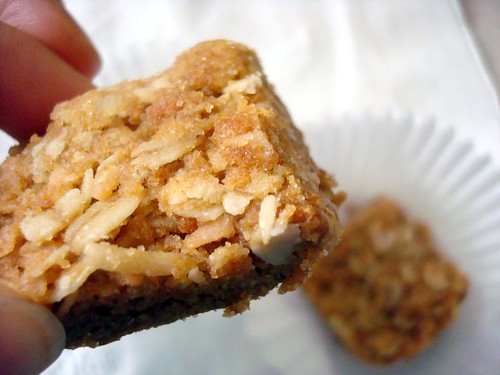
I first discovered Crunchies, a (natch) crunchy South African bar cookie, when CakeSpy Buddy Naomi handed one to me and said "eat this". Of course I was more than happy to oblige. Now, these cookies (made by local catering company On Safari) vaguely resembled granola bars, but one bite made the difference achingly clear. These cookies have a flavor that granola bars could only aspire to: crunchy, salty-sweet, coconutty, and very buttery.
So what's the deal with these cookies?
As one South African blogger reminisced,
Growing up in South Africa, the one cookie-tin constant that every child will remember is crunchies. They were usually one of the first things that your mom let you bake and kept forever in an airtight container, so we all grew up on crunchies. To me, they were distressingly unglamorous....but they certainly were a stalwart of every cookie tin that I remember growing up.
Want to make some crunchies? While On Safari's recipe is proprietary, I did find a crunchie recipe on the Hulett's Sugars (a South African manufacturer of sweeteners) which seems pretty legit.
South African Crunchies
- 310ml (1¼ cups) flour
- 310ml (1¼ cups) breakfast oats
- 310ml (1¼ cups) coconut
- 185ml (¾ cups) Huletts White Sugar
- 20ml (4 teaspoons) Huletts Golden Syrup
- 125ml (½ cup) butter or brick margarine
- 5ml (1 teaspoon) bicarbonate of soda
- 45 - 60ml boiling water
- Combine dry ingredients.
- Melt the Huletts Golden Syrup and butter together. Combine the bicarbonate of soda with the water and add to the butter mixture.
- Mix together with the dry ingredients.
- Press the mixture into a Swiss roll tin (or for a thicker crunchie, bake in a square 20cm x 20cm tin) and bake for 20 minutes at 150ºC. Gently press down the sides if they seem to rise too much.
- When light brown, remove from the oven and cut into squares. Switch off the oven. Return crunchies to the oven, for about 10 minutes to dry out.
- Allow to cool before removing from tin.


